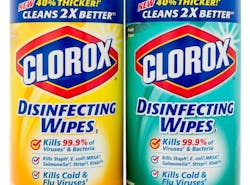The rollout includes a full list of ingredients on the container labels of all 350 registered household disinfectants, as well as the 300 non-registered Clorox products covered by the Cleaning Product Right to Know law in California. This law requires online disclosure by Jan. 1, 2020.
Related: Reduce Custodian Staff Turnover by Giving Thanks
Clorox opted for the law’s most detailed labeling option and will disclose every intentionally added ingredient on the label of every relevant product as the updated labels gradually receive approval from regulators.
Similar legislation is under consideration in Maryland, Minnesota and Oregon and a similar law passed in New York in 2017, so more companies may follow Clorox’s lead soon to continue selling cleaning products in those states.
The company will also add 400 cleaning products and 40 food products to SmartLabel, a searchable online portal that shares accurate product information directly from manufacturers.
“Clorox’s decision to go above and beyond the requirements of the law is consistent with our pioneering approach to ingredient transparency within our industry,” explains Benno Dorer, Clorox chair and CEO. “We’re proud to continue building on these efforts as part of our overall commitment to good growth that’s profitable, sustainable and responsible.”
Clorox’s other sustainable achievements include:
- Aiming for 20 percent reductions in greenhouse gas emissions, energy consumption, water use and waste-to-landfill in manufacturing and distribution by 2020
- Looking for ways to emit less sulfur oxide, nitrous oxide, VOCs and fluorinated gases
- Introducing a scorecard for its top 100 suppliers to track the relative sustainability of the supply chain
Product transparency and material health information are increasingly important for both health-conscious building occupants and for earning credits toward building certifications like LEED and the Living Building Challenge.
However, differing approaches to product health have led to a diversity of product information sources. None of the available ecolabels are necessarily better or more important than the others, but choosing the right transparency labels (and the right products) means asking yourself a few important questions.
For example:
- Are you simply trying to research the relative environmental impact of ingredients you already know, such as the ones Clorox will soon release? If so, the Pharos Project might be your best bet. This database catalogs chemicals, polymers and other materials that might show up in your products.
- If you prioritize certain aspects of material health, you might benefit more from looking at specialized product health certifications. These include the Cradle to Cradle Product Standard, GREENGUARD (a certification that focuses on VOC emissions) and Health Product Declarations (which focus on human health impacts).
- A procurement policy that focuses more on transparency and the availability of information is better aligned with labels like Declare (a “nutrition label” of sorts that lists ingredients, end of life disposal information, life expectancy and other factors) or resources like Environmental Product Declarations, which are longer, more detailed documents that walk readers through the environmental impacts of a product’s entire lifecycle but don’t necessarily imply that the product is environmentally superior to its competitors.
- Shopping for a particular type of product will be easier when you limit your ecolabel search to certifications for specific product types, such as FloorScore for flooring or these three options for wood and paper products.
When it comes to janitorial products, however, the coming implementation of the Cleaning Product Right to Know Act may be the most comprehensive resource available.
The law requires disclosure of all intentionally added ingredients, as well as any nonfunctional constituents that make up more than 0.01 percent of the product, Chemical Abstracts Service identification numbers for the ingredients, links to hazard safety data sheets and more.
And, like Title 24 before it, this law will likely impact best practices across the country sooner rather than later even if other states don’t implement a similar requirement.
Two handpicked articles to read next:
About the Author
Janelle Penny
Editor-in-Chief at BUILDINGS
Janelle Penny has been with BUILDINGS since 2010. She is a two-time FOLIO: Eddie award winner who aims to deliver practical, actionable content for building owners and facilities professionals.

